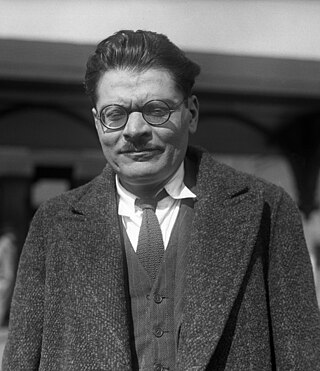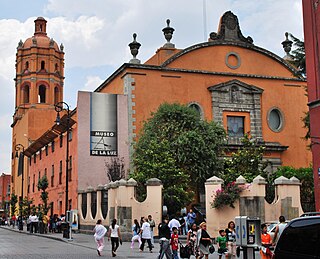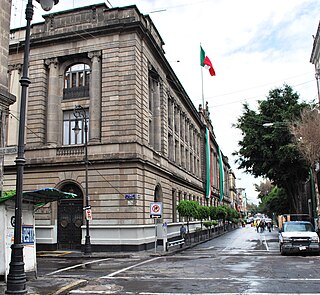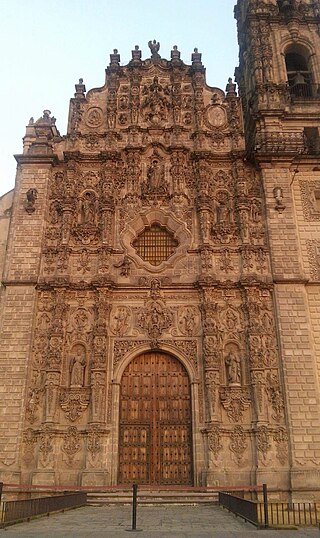
David Alfaro Siqueiros was a Mexican social realist painter, best known for his large public murals using the latest in equipment, materials and technique. Along with Diego Rivera and José Clemente Orozco, he was one of the most famous of the "Mexican muralists".

José Clemente Orozco was a Mexican caricaturist and painter, who specialized in political murals that established the Mexican Mural Renaissance together with murals by Diego Rivera, David Alfaro Siqueiros, and others. Orozco was the most complex of the Mexican muralists, fond of the theme of human suffering, but less realistic and more fascinated by machines than Rivera. Mostly influenced by Symbolism, he was also a genre painter and lithographer. Between 1922 and 1948, Orozco painted murals in Mexico City, Orizaba, Claremont, California, New York City, Hanover, New Hampshire, Guadalajara, Jalisco, and Jiquilpan, Michoacán. His drawings and paintings are exhibited by the Carrillo Gil Museum in Mexico City, and the Orozco Workshop-Museum in Guadalajara. Orozco was known for being a politically committed artist, and he promoted the political causes of peasants and workers.

The Polyforum Cultural Siqueiros is a cultural, political and social facility located in Mexico City as part of the World Trade Center Mexico City. It was designed and decorated by David Alfaro Siqueiros in the 1960s and hosts the largest mural work in the world called La Marcha de la Humanidad. The building has a theatre, galleries and more, but the main focus is the Forum Universal, which contains the interior portion of Siqueiros' mural work. Visitors can experience the mural while standing on a rotating stage, listening to Siqueiros narrate.

Louis Henri Jean Charlot was a French-born American painter and illustrator, active mainly in Mexico and the United States.
José Raúl Anguiano Valadez was a notable Mexican painter of the 20th century, part of the “second generation” of Mexican muralists which continued the tradition of Diego Rivera, José Clemente Orozco and David Alfaro Siqueiros but experimented with it as well. Anguiano was born during the height of the Mexican Revolution, which would inspire a majority of his mural painting. He studied painting in his hometown of Guadalajara before moving to Mexico City to begin his career. His first major exhibition was held at the Palacio de Bellas Artes, at age 20. His works include over 100 individual and collective exhibitions with 50 murals, mostly in Mexico and the United States. As he continued his artistry with aspects of the Mexican muralism movement, he also experimented with other styles such as Cubism, Surrealism and Expressionism, with themes such as clowns and prostitutes. However, his most famous painting is “La espina” which depicts a Mayan woman digging a thorn out of her foot with a knife. His later works concentrated on depicting Mexico in vivid colors and traditional imagery.

The Escuela Nacional Preparatoria (ENP), the oldest senior High School system in Mexico, belonging to the National Autonomous University of Mexico (UNAM), opened its doors on February 1, 1868. It was founded by Gabino Barreda, M.D., following orders of then President of Mexico Benito Juárez. It is also modern UNAM's oldest institution.

José Chávez Morado was a Mexican artist who was associated with the Mexican muralism movement of the 20th century. His generation followed that of Diego Rivera, José Clemente Orozco and David Alfaro Siqueiros. Although Chávez Morado took classes in California and Mexico, he is considered to be mostly self-taught. He experimented with various materials, and was an early user of Italian mosaic in monumental works. His major works include murals at the Ciudad Universitaria, Secretaría de Comunicaciones y Transportes and Museo Nacional de Antropología in Mexico City as well as frescos at the Alhóndiga de Granaditas, which took twelve years to paint. From the 1940s on, he also worked as a cultural promoter, establishing a number of cultural institutions especially in his home state of Guanajuato including the Museo de Arte Olga Costa - José Chávez Morado, named after himself and his wife, artist Olga Costa.

Mexican muralism refers to the art project initially funded by the Mexican government in the immediate wake of the Mexican Revolution (1910-1920) to depict visions of Mexico's past, present, and future, transforming the walls of many public buildings into didactic scenes designed to reshape Mexicans' understanding of the nation's history. The murals, large artworks painted onto the walls themselves had social, political, and historical messages. Beginning in the 1920s, the muralist project was headed by a group of artists known as "The Big Three" or "The Three Greats". This group was composed of Diego Rivera, José Clemente Orozco and David Alfaro Siqueiros. Although not as prominent as the Big Three, women also created murals in Mexico. From the 1920s to the 1970s, murals with nationalistic, social and political messages were created in many public settings such as chapels, schools, government buildings, and much more. The popularity of the Mexican muralist project started a tradition which continues to this day in Mexico; a tradition that has had a significant impact in other parts of the Americas, including the United States, where it served as inspiration for the Chicano art movement.

The Caricature Museum is located in an 18th-century Baroque building in the historic center of Mexico City. It was opened in 1987 to preserve and promote the history of Mexican cartooning, done for both political and entertainment purposes. The historic building it occupies was originally the home of Cristo College, a royal college established in 1612.
Amado de la Cueva was a Mexican painter. De la Cueva studied in Rome. After his return to Mexico in September 1922, he painted amongst others together with Diego Rivera his murals at the Secretaría de Educación Pública. On October 16, 1923, he returned to his home town, where he painted the murals at Universidad de Guadalajara's assembly hall together with David Alfaro Siqueiros and Carlos Orozco after 1925.

The San Pedro y San Pablo College is a colonial church located in the historical center of Mexico City, Mexico.

Ramón Alva de la Canal was a Mexican painter, illustrator, and educator, one of the pioneers of the Mexican muralism movement.

The Secretariat of Public Education Main Headquarters building is on the northeast corner of San Ildefonso and República de Argentina streets in the historic center of Mexico City, and used to be part of the largest and most sumptuous convents in New Spain. It was secularized in the 19th century and then taken over by the then-new Secretariat of Public Education after the Mexican Revolution in the early 20th century. The new agency did extensive remodeling work on the building, including covering nearly all the walls of the two inner courtyards with murals. These murals include Diego Rivera’s first large-scale mural project, which he completed in 1928.

The Museo Nacional del Virreinato is located in the former College of San Francisco Javier in Tepotzotlán, Mexico State, Mexico. It belongs to Consejo Nacional para la Cultura y las Artes. The complex was built by the Aztecs, and used by the Jesuits starting in the 1580s. Three centers of learning were founded in the complex: a school to teach indigenous languages to Jesuit evangelists, a school for native boys, and the College of San Francisco Javier, to train Jesuit priests. The complex comprises three sections: the college area, with dormitories, a library, a kitchen, and a domestic chapel; the Church of San Francisco Javier; and the Church of San Pedro Apostol. The former college and the Church of San Francisco Javier have been converted into the Museo del Virreinato, with the former college area housing a large collection of art and ordinary objects from the colonial era, and the Church of San Francisco Javier housing one of the most important collections of Churrigueresque altarpieces in Mexico. The Church of San Pedro Apostol is the only part of the entire complex that is still used for religious purposes.

The Antigua Escuela de Jurisprudencia building is located on the corner of Republica de Argentina and San Ildefonso Streets in the historic center of Mexico City. The building originally was convent for Dominican nuns called Santa Catalina de Siena.After the Reform Laws the government took possession of the building and worked to turn it into a military barracks, transforming and partially demolishing it. In the meantime, the National University of Mexico, the forerunner of UNAM, had been closed in 1833, and the Jurisprudence School was recreated at the College of San Ildefonso. In 1868, the National Preparatory High School was founded in the same building so the Jurisprudence School moved to the ex Convent of La Encarnación,(now SEP) and finally to the ex Convent of Santa Catalina de Siena. In 1908, Diaz inaugurated this building as the Escuela Nacional de Jurispudencia.
The Colegio de San Ildefonso was an educational institution run by the Society of Jesus in Cebu City, Philippines in the then Spanish Captaincy General of the Philippines. It was established by the Jesuits in 1595 thus making it the first European-founded educational institution in Asia. In Mexico City, the Jesuits had founded a college with the same name in 1588. The Cebu City college was established by Fr. Antonio Sedeño, Fr. Pedro Chirino, and Antonio Pereira of the Society of Jesus in August 1595. After the expulsion of the Jesuits from Spanish territories in 1767, the buildings and facilities were taken over by the Diocese of Cebu, then by the Congregation of the Mission, and later by the Society of the Divine Word.

Fernando Leal was one of the first painters to participate in the Mexican muralism movement starting in the 1920s. After seeing one of his paintings, Secretary of Education José Vasconcelos invited Leal to paint at the Escuela Nacional Preparatoria. The resulting work is Los danzantes de Chalma. Leal also painted a mural dedicated to Simón Bolívar at the Anfiteatro Bolivar, as well as religious murals such as those at the chapel dedicated to the Virgin of Guadalupe at the Basilica Villa in Tepeyac.

Xavier Guerrero was one of the pioneers of the Mexican muralism movement in the early 20th century. He was introduced to painting through working with his father, who worked in masonry and decorating. However, there is evidence that his ability was mostly self-taught. In 1912, he moved to Guadalajara and began painting murals, then to Mexico City in 1919 just as the muralism movement was about to begin. Most of his work was in collaboration with or subordinate to other painters such as Diego Rivera and David Alfaro Siqueiros, working at the San Ildefonso College, the Secretaría de Educación Pública building and the Universidad Autónoma de Chapingo; however, much of his other work has been lost. While best known for his mural work, his later canvas work is considered to be better.

The Museum of Light is a science museum dedicated to the phenomena of light, located in the former San Ildefonso College in the historic center of Mexico City. It was opened in 1996 originally in the former church of the San Pedro y San Pablo College. However, this building was closed in 2010 in order to convert it into the Museum of the Constitutions. The Museum of Light was moved to its current and larger location, but it remains an extension of the Universum museum, the general science museum of the Universidad Nacional Autónoma de México.
Mario Orozco Rivera was a Mexican muralist and painter, a later proponent of Mexican muralism, and whose work was particularly influenced by David Alfaro Siqueiros. He created a number of murals, mostly in the state of Veracruz before becoming an assistant to Siqueiros, directing the Taller Siqueiros in Cuernavaca and working with the artists on projects such as the Polyforum Cultural Siqueiros. While preferring mural work, which he considered less commercial, Orozco Rivera also created oils and sculptures. Many of these works were exhibited in Mexico and abroad and can be found in many major collections. His work received recognition in various countries.




























